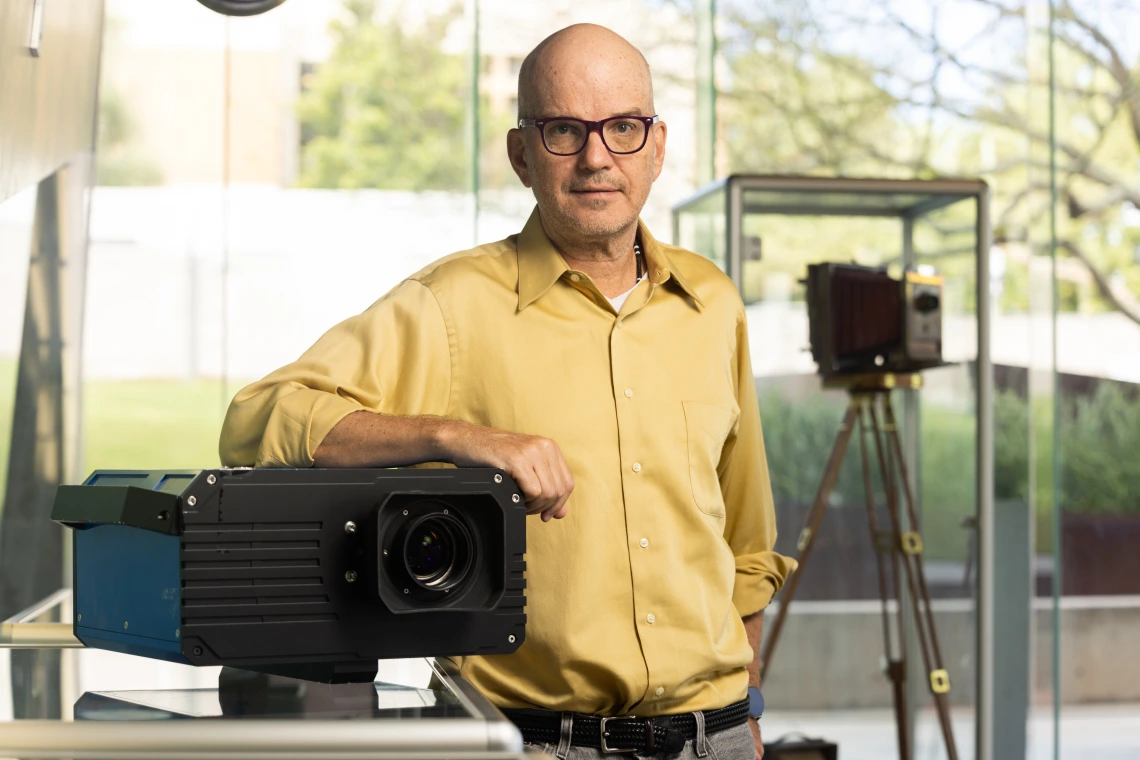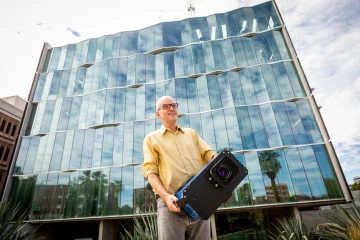In The DNA
Pushing the edges of what is possible

Chris Richards Photo
David Brady hops on the streetcar to head to work every day at 6:45 a.m. With an “obsession” to build better cameras, he calls the University of Arizona “the best place in the world to do optics.”
"The College of Optical Sciences is a very special community,” he says. “There are things that are possible here that just aren’t possible anywhere else.”
Brady accepted his position as the J.W. and H.M. Goodman Endowed Chair in Optical Sciences in 2021. At the time, he was at Duke University, where he had partnered with UArizona scientists to build the world’s first gigapixel camera in 2012. Much of his work pushes the limits of visual information by several orders of magnitude, he says.
“Visual information changes the way we interact with the world. Now we have Google Maps and Google Street View. People are connected in ways they never were before. … Social justice and the way society is structured — those things are driven by visual evidence, pictures of things, recordings of different events. It changes the way we interact and hopefully makes us more human.”
Photography is a part of Brady’s DNA. His great-great-grandfather was a photographer in the late 19th and early 20th century. A camera looked like a big box then — the size of a person, he says. “My father gave me a darkroom for Christmas one year. It wasn’t because he wanted me to have one — he wanted a darkroom. And his excuse was to get one for me. So, I always knew about photography.”
Brady is drawn to the physical limits of light. He says he’s not interested in taking pictures of amazing things, as did Ansel Adams, for example. His interest is more intellectual — photography as an information science and its intersection with physics. “And that relates to: How are bits carried on a wave, and what are the limits of how many bits we can carry on different kinds of waves?” he says.
In the case of a camera, waves interact with the lens. He compares a camera to a computer that just happens to take pictures. “The people who are pioneering photography now speak the language of fundamental physics and computers, because that’s what cameras have become,” he says.

Chris Richards Photo
For him, pushing the limits is a compulsion. “Communication systems and computers are a million times faster. Cameras are not. If I looked at a picture from, like, 30 to 40 years ago, the resolution would be about the same as the cameras we have today. I’d like to change that.”
To make it happen, he works alongside some of the best optics experts in the world, he says. “They will help push a vision that makes digital media integrated and richer.” Soon they will work together in the donor supported Grand Challenges Research Building, a nearly 115,000-square-foot facility that will connect to the Meinel Optical Sciences Building. The new facility is expected to be completed in early 2024.
“To bring world-class people together around a common theme changes society,” Brady says. “It’s about a collection of people that are working together — pulling a broader cross-section of researchers into one space to push the edges of what is possible.”
Thanks to generous donor support, many of Brady’s colleagues also hold endowed chair positions. In January, the college announced that it had completed a three-year endowed chair campaign, having raised $28 million in donations and commitments to establish 14 new endowed chairs. Each endowment has been or will be established with initial gifts totaling $2 million. Namesakes for 12 of the chairs have been announced.
“Having an endowed chair honors pioneers in the creation of our society and creates a narrative that helps people understand that real people are doing this work,” Brady says. “The College of Optical Sciences has a deep history, with ties to astronomy and the James Webb Space Telescope, for example. It is the human quest to understand our place in the universe at the most fundamental level — it speaks to a quest for excellence that is very exciting.”
—Sarah Beaudry
JAMES C. WYANT COLLEGE OF OPTICAL SCIENCES $28 MILLION ENDOWED CHAIR CAMPAIGN
A three-year fundraising campaign began in 2018 following a gift from Harrison and Catherine Barrett to establish the Harrison H. and Catherine C. Barrett Endowed Chair in Optical Sciences for Cancer Imaging. James Wyant and his family then made a $20 million gift to the college to support creation of new faculty positions.
The $20 million gift was placed into the Distinguished Endowed Chair in Optical Sciences Fund and came with an invitation to others interested in giving to the college. Each time a donor or a donor group pledged $500,000 to create a new endowed faculty chair, $1.5 million from the fund was added to bring the initial gifts to each endowed chair to $2 million. The endowed chair was then named by the donor or donor group.

